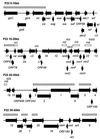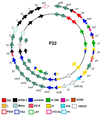Sequence of the genome of Salmonella bacteriophage P22
- PMID: 11053393
- PMCID: PMC94795
- DOI: 10.1128/JB.182.22.6472-6481.2000
Sequence of the genome of Salmonella bacteriophage P22
Abstract
The sequence of the nonredundant region of the Salmonella enterica serovar Typhimurium temperate, serotype-converting bacteriophage P22 has been completed. The genome is 41,724 bp with an overall moles percent GC content of 47.1%. Numerous examples of potential integration host factor and C1-binding sites were identified in the sequence. In addition, five potential rho-independent terminators were discovered. Sixty-five genes were identified and annotated. While many of these had been described previously, we have added several new ones, including the genes involved in serotype conversion and late control. Two of the serotype conversion gene products show considerable sequence relatedness to GtrA and -B from Shigella phages SfII, SfV, and SfX. We have cloned the serotype-converting cassette (gtrABC) and demonstrated that it results in Salmonella serovar Typhimurium LT2 cells which express antigen O1. Many of the putative proteins show sequence relatedness to proteins from a great variety of other phages, supporting the hypothesis that this phage has evolved through the recombinational exchange of genetic information with other viruses.
Figures


Similar articles
-
Genomic structure of the Salmonella enterica serovar Typhimurium DT 64 bacteriophage ST64T: evidence for modular genetic architecture.J Bacteriol. 2003 Jun;185(11):3473-5. doi: 10.1128/JB.185.11.3473-3475.2003. J Bacteriol. 2003. PMID: 12754248 Free PMC article.
-
Transcriptional Organization of the Salmonella Typhimurium Phage P22 pid ORFan Locus.Int J Mol Sci. 2022 Jan 23;23(3):1253. doi: 10.3390/ijms23031253. Int J Mol Sci. 2022. PMID: 35163175 Free PMC article.
-
Genomic analysis of bacteriophage epsilon 34 of Salmonella enterica serovar Anatum (15+).BMC Microbiol. 2008 Dec 17;8:227. doi: 10.1186/1471-2180-8-227. BMC Microbiol. 2008. PMID: 19091116 Free PMC article.
-
Genomic sequences of bacteriophages HK97 and HK022: pervasive genetic mosaicism in the lambdoid bacteriophages.J Mol Biol. 2000 May 26;299(1):27-51. doi: 10.1006/jmbi.2000.3729. J Mol Biol. 2000. PMID: 10860721
-
Salmonella phages and prophages--genomics and practical aspects.Methods Mol Biol. 2007;394:133-75. doi: 10.1007/978-1-59745-512-1_9. Methods Mol Biol. 2007. PMID: 18363236 Review.
Cited by
-
A BTP1 prophage gene present in invasive non-typhoidal Salmonella determines composition and length of the O-antigen of the lipopolysaccharide.Mol Microbiol. 2015 Apr;96(2):263-75. doi: 10.1111/mmi.12933. Epub 2015 Feb 11. Mol Microbiol. 2015. PMID: 25586744 Free PMC article.
-
Discrimination within phenotypically closely related definitive types of Salmonella enterica serovar typhimurium by the multiple amplification of phage locus typing technique.J Clin Microbiol. 2005 Apr;43(4):1604-11. doi: 10.1128/JCM.43.4.1604-1611.2005. J Clin Microbiol. 2005. PMID: 15814973 Free PMC article.
-
A P22 scaffold protein mutation increases the robustness of head assembly in the presence of excess portal protein.J Virol. 2002 Oct;76(20):10245-55. doi: 10.1128/jvi.76.20.10245-10255.2002. J Virol. 2002. PMID: 12239300 Free PMC article.
-
Phase variation controls expression of Salmonella lipopolysaccharide modification genes by a DNA methylation-dependent mechanism.Mol Microbiol. 2010 Jul;77(2):337-53. doi: 10.1111/j.1365-2958.2010.07203.x. Epub 2010 May 12. Mol Microbiol. 2010. PMID: 20487280 Free PMC article.
-
Corrected sequence of the bacteriophage p22 genome.J Bacteriol. 2003 Feb;185(4):1475-7. doi: 10.1128/JB.185.4.1475-1477.2003. J Bacteriol. 2003. PMID: 12562822 Free PMC article.
References
-
- Adams M D. Bacteriophages. New York, N.Y: Interscience Publishers, Inc.; 1959.
-
- Allison G E, Verma N K. Serotype-converting bacteriophages and O-antigen modification in Shigella flexneri. Trends Microbiol. 2000;8:17–23. - PubMed
-
- Altschul S F, Gish W, Miller W, Myers E W, Lipman D J. Basic local alignment search tool. J Mol Biol. 1990;215:403–410. - PubMed
Publication types
MeSH terms
Substances
Associated data
- Actions
LinkOut - more resources
Full Text Sources
Other Literature Sources
Miscellaneous

